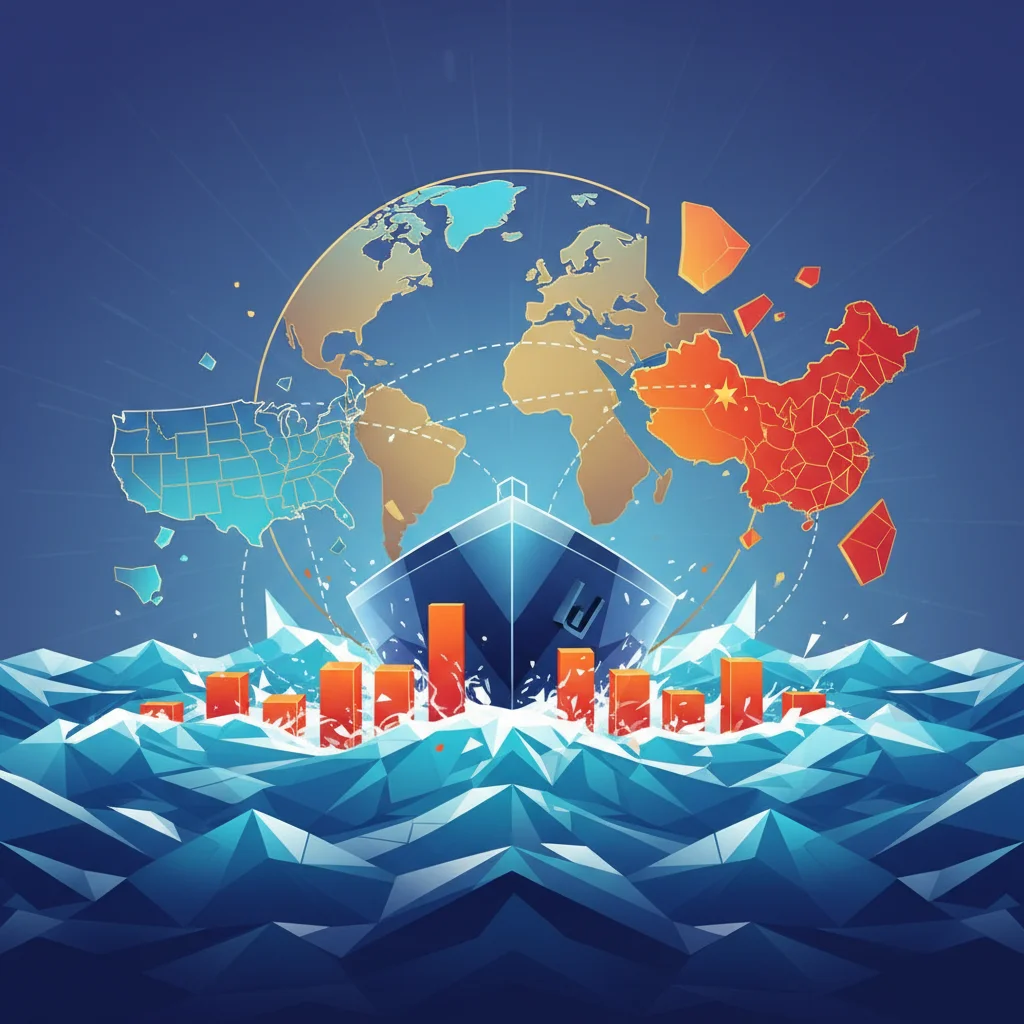
Navigating Choppy Waters: How New US Port Fees on Chinese Ships Will Reshape Global Trade
The Quiet Escalation: A New Front in the US-China Economic Rivalry
The intricate dance of global economics is often defined by grand pronouncements and sweeping tariffs. Yet, sometimes, the most significant moves are the most subtle. As of October 14th, the United States has initiated a new, more nuanced strategy in its ongoing economic competition with China by beginning to collect fees on China-linked ships. While this may not grab headlines like the multi-billion dollar tariff wars of the past, for those in finance, logistics, and international business, this development is a critical signal. It represents a shift from broad-based economic pressure to a more surgical approach, targeting the very arteries of global trade: maritime shipping.
This move is far more than a simple administrative fee. It’s a calculated policy designed to address long-standing allegations of unfair trade practices within the global shipping industry. For investors, business leaders, and anyone with a stake in the global economy, understanding the implications of this policy is paramount. It signals a new chapter in US-China relations, one that will have cascading effects on supply chains, inflation, and the broader stock market. In this analysis, we will dissect the new port fees, place them within their historical context, and explore the strategic adjustments required to navigate this evolving landscape.
Deconstructing the Port Fee Policy
At its core, the new measure targets container ships that are either Chinese-flagged, Chinese-built, or Chinese-owned. The policy stems from a petition filed by a US-based shipping company, which alleged that the Chinese government’s extensive subsidies give its maritime industry an unfair competitive advantage. The US Federal Maritime Commission (FMC) investigated these claims and found evidence of “unfavorable shipping conditions” created by China’s policies, prompting this retaliatory action.
The fees are not a blanket tariff on goods but a charge levied directly on the vessels themselves. This distinction is crucial. It aims to level the playing field for shipping operators rather than directly taxing consumers on specific products. However, the downstream effects are inevitable. Increased operational costs for shipping lines are almost certain to be passed on to their customers—the importers and exporters—and, ultimately, to the end consumer. This could introduce a new, persistent inflationary pressure just as global central banks, including the Federal Reserve, are fighting to bring price levels under control. The world of international economics is watching closely to see how these costs are absorbed or deflected across the value chain.
This policy also highlights the growing importance of logistical infrastructure in geopolitical strategy. By targeting ships, the US is applying pressure to a foundational element of China’s export-driven economic model, potentially disrupting the cost-effectiveness that has long been its hallmark.
A Timeline of Tense Tides: Contextualizing the Current Climate
Today’s port fees did not emerge from a vacuum. They are the latest chapter in a multi-year saga of economic friction between the world’s two largest economies. Understanding this history is essential for appreciating the significance of the current moment. The conflict has evolved from loud, public disputes over tariffs to more targeted measures aimed at technology, finance, and now, logistics.
Below is a simplified timeline of key events that have shaped the current US-China trade relationship, providing context for the new maritime measures.
| Year | Key Event | Economic Impact & Significance |
|---|---|---|
| 2018 | US imposes sweeping tariffs on over $360 billion of Chinese goods, citing intellectual property theft and unfair trade practices (source). | Marks the official start of the modern trade war. Disrupts global supply chains and increases costs for businesses and consumers. |
| 2020 | Signing of the “Phase One” trade deal. China commits to increasing purchases of US goods and services. | A temporary de-escalation, but many foundational issues and tariffs remain unresolved. The deal’s targets were largely unmet. |
| 2021-2022 | Focus shifts to technology. The US places numerous Chinese tech firms, like Huawei, on the “Entity List,” restricting their access to US technology. | The conflict broadens from trade to a “tech war,” impacting the semiconductor industry and global tech development. |
| 2023 | US enacts restrictions on American investing in certain Chinese technology sectors, including AI and quantum computing. | The battle extends into capital markets and finance, aiming to slow China’s technological advancement by limiting access to funding. |
| 2024 | US begins collecting fees on China-linked ships, targeting maritime logistics. | Represents a new, surgical approach targeting infrastructure and the mechanics of trade itself, not just the goods being traded. |
This progression shows a clear pattern: as the global economy becomes more interconnected, the tools of economic competition become more sophisticated. The focus has moved from finished goods to the underlying technology, capital flows, and now, the physical means of transport.
The Ripple Effect: From Ports to Portfolios
The immediate impact of the port fees will be felt in the shipping and logistics sectors, but the ripple effects will spread throughout the global financial system. Investors and business leaders must anticipate these secondary consequences.
1. Supply Chain Recalibration
For years, businesses have been discussing a “China plus one” strategy to diversify their supply chains. This policy will act as a powerful accelerant. The added costs and potential for future logistical frictions will force companies to more seriously evaluate manufacturing and sourcing in other regions like Vietnam, India, Mexico, and Eastern Europe. This shift presents both risks for companies heavily reliant on China and opportunities for those positioned to benefit from this global manufacturing realignment.
2. The Specter of Inflation
Any increase in transportation costs ultimately finds its way to the consumer. While the immediate impact of these fees may be modest, they contribute to a “new normal” of higher logistical expenses. This persistent, low-level inflationary pressure could complicate the work of central banking institutions trying to maintain price stability, potentially leading to a “higher for longer” interest rate environment. This has significant implications for equity valuations and bond markets.
3. Sector-Specific Stock Market Volatility
The stock market will not react uniformly.
- Losers: Companies with high dependence on Chinese manufacturing and transatlantic shipping routes may see margin compression. This includes large retailers, electronics manufacturers, and industrial goods companies. Shipping lines with significant China-linked fleets will face direct cost increases.
- Winners: Logistics and shipping companies from other nations could gain a competitive edge. Domestic manufacturers in the US and companies in emerging markets poised to receive relocated production could see long-term benefits. A keen eye on corporate earnings calls for commentary on supply chain costs will be crucial for active trading strategies.
4. The Rise of Supply Chain Technology
In an environment of increasing trade friction, visibility and efficiency become paramount. This is a significant tailwind for the financial technology (fintech) and blockchain sectors. Companies are desperately seeking solutions for:
- Enhanced Transparency: Blockchain-based platforms can provide an immutable record of a product’s journey, helping to verify origin and navigate complex customs and fee structures.
- Efficient Cross-Border Payments: Fintech solutions can streamline international payments, hedge against currency risk, and provide trade finance to companies re-tooling their supply chains.
- Predictive Analytics: AI and machine learning platforms that can model and predict the impact of geopolitical events on shipping lanes and costs will become indispensable tools for risk management. The intersection of financial technology and logistics is set to be a major growth area.
Strategic Imperatives for a New Era of Trade
Navigating this landscape requires a proactive, not reactive, approach. Both investors and corporate leaders must adapt their strategies.
For those focused on investing, this means looking beyond simple country-based allocations. The new paradigm demands a focus on corporate resilience. Portfolios should be stress-tested for geopolitical risk, with an emphasis on companies that have diversified supply chains, strong pricing power to pass on costs, and a technological edge in managing logistics. It may also be a time to explore thematic investments in areas like near-shoring, industrial automation, and supply chain tech.
For business leaders, the message is clear: the cost of inaction is rising. A full-scale audit of supply chain vulnerabilities is no longer optional. This involves mapping out every tier of your supplier network, quantifying the financial impact of potential disruptions, and actively investing in alternative sourcing locations. Building agility and redundancy into your operations is the only effective hedge against the geopolitical uncertainties that now define international commerce.
Conclusion: The End of the Old World Order
The introduction of US port fees on China-linked ships is a testament to a changing world. It confirms that the era of hyper-globalization, characterized by a relentless drive for efficiency above all else, is giving way to a new era defined by resilience, national security, and strategic competition. These fees are not just a line item on a shipping invoice; they are a policy statement with far-reaching consequences for the global economy.
For everyone from the Wall Street trader to the main street business owner, the key to success will be understanding that geopolitical risk is now a permanent feature of the financial landscape. The ability to anticipate, adapt, and innovate in the face of these challenges will separate the winners from the losers in the choppy waters of 21st-century global trade.


